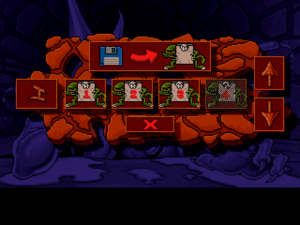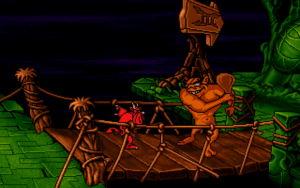Litil Divil: Farewell Maze 4
I’ve finally made it to the fifth maze! Only temporarily, though. As usual, I didn’t find the save room on my first visit, so the next time I play, I’m going to be retracing some ground on level 4. Fortunately, that path isn’t so bad. There are two challenges remaining on it, both far enough past the save room to make it not worth going back, but they’re both things I’ve cracked. One is a pure puzzle, with Mutt and a sort of minotaur-like bruiser taking turns stepping around on a life-sized chessboard where certain marked squares have effects on the opponent’s position. I haven’t worked out the meanings of the marks, but the board doesn’t change, and neither does the opponent’s movement algorithm, so once you’ve found a sequence that works, you can just key it in without risk.
The other is a moving platforms scene, a relative of the lava crossing I mentioned before. I’ve come to dread these things. They tend to be the hardest challenges in the game, owing not just to the difficulty of the execution but the random elements that can wreck you at the last minute. In other words, they’re the sort of thing that I try to win once, then head back to the save room so I don’t have to do it again. But this one is much closer to the level exit than to the save room, making that a harder call. Gladly, though, it turned out to be quite manageable, once I had observed it enough. The room has three rows of platforms, two rows moving right separated by a sparser left-moving row, which you have to cross to reach a couple of buttons at the room’s extremes, then cross back to reach the door they opened. Riding the platforms across the room at random are two guys with green robes and distance weapons, ready to knock you into the abyss when you’re on the same row. The key to the whole thing is noticing that the two guys have different weapons: one has a spear, the other a bow and arrow. When the spear guy throws it at you, he doesn’t get it back until he’s carried all the way off the screen. So the the first thing you need to do is jump onto his row and then off again, to make him waste his spear. The bow and arrow, meanwhile, takes three hits to knock you off, provided you don’t panic and try to dodge onto a platform that’s out of reach. So you can afford to simply let him hit you a couple of times while waiting for your stop.
This is a pretty satisfying puzzle, in large part because the tactics that make it easier are so easily articulated. If you asked me how to defeat the earlier lava sequence, or the even earlier bubble room that I haven’t mentioned before now, I wouldn’t know what to tell you. It would be a lot of “Wait until the time is right. You’ll know it after you’ve seen it happen six or seven times.”
 Comments(0)
Comments(0)
